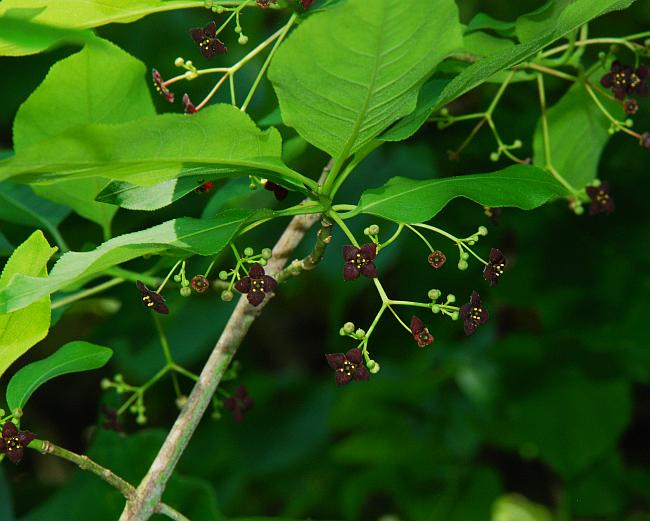Euonymus atropurpureus Jacq.
Wahoo

Native
CC = 5
CW = 3
MOC = 76
© SRTurner
Euonymus atropurpureus Jacq.Wahoo | |
 |
Native CC = 5 CW = 3 MOC = 76 |
© SRTurner |
|
Family - Celastraceae Habit - Shrub or small tree 2-6 m tall. Stem - Twigs green, gray, or less commonly brownish purple, circular in cross-section.
Leaves - Opposite, simple, petiolate. Petioles 10-20 mm long. Leaf blades 4-14 cm long, 2-7 cm wide, thin and herbaceous, elliptic to narrowly ovate or ovate, narrowed or tapered at the base, narrowed or tapered to a usually sharply pointed tip, the margins finely and usually sharply toothed.
Inflorescences - Small axillary panicles with 6-24 flowers.
Flowers - usually perfect (rarely functionally staminate or pistillate). Sepals 4, 1.0-1.5 mm long, fused toward the base. Petals 4, 2-3 mm long, 1.5-2.5 mm wide, dark reddish-brown. Stamens 4, these inserted along the margin of the nectar disc, the filaments minute. Ovary usually with 1-5 locules and 2-6 ovules per locule. Style short, stout, the stigma entire or shallowly 3-lobed.
Fruits - Capsules 6-10 mm long, 2-4-lobed from the tip to about the midpoint, the valves smooth, pink, fading to tan. Seeds 1-6 per locule, 4-5 mm long. Seeds 1-6 per locule, 4-5 mm long, ovoid to ellipsoid, brown, each enclosed in a fleshy red to orange aril.
Flowering - April - June. Habitat - Bases and ledges of bluffs, forests, glade margins, upland prairies. Origin - Native to the U.S. Lookalikes - Vegetatively resembles a number of other shrubs, particularly E. alatus and E. europaeus. Other info. - This native shrub is fairly common throughout Missouri. Its U.S. distribution is mainly in the Midwest, becoming less common toward the Atlantic coast. Somewhat nondescript vegetatively, it becomes impossible to mistake when in flower or fruit. The flowers are small and brownish but interesting up close, and the fruits in fall are a showy neon pink. The leaves are opposite on relatively long petioles, and the small terminal bud (between the most apical pair of leaves on a branch) is distinctive. The plant is a common find in good-quality woodlands at the bases of bluffs. Photographs taken along the Al Foster trail, St. Louis County, MO, 5-24-2010, at LaBarque Creek Conservation Area, Jefferson County, MO, 5-30-2011, along the Katy Trail near Dutzow, 10-30-2013 and 11-5-2019, at Shaw Nature Reserve, Franklin County, MO, 5-21-2015, and at Bootleg Access, Washington County, MO, 6-9-2025 (SRTurner). |